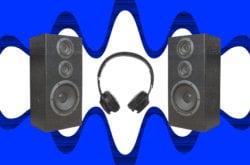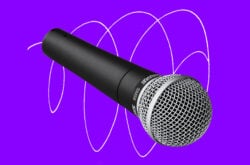As more producers and engineers work from home, bedroom studio setups are becoming more and more sophisticated.
However, it’s common for home setups to fall victim to one of a few main issues, which can lead to less-than-ideal results. In this post, we’ll go over a few of the most widespread studio setup mistakes that producers, engineers, and audio enthusiasts make when setting up and using their home studio.
1. Investing in a nice mic (without investing in room treatment)
Dropping thousands on a microphone won’t automatically make you sound better; in fact, it’ll likely capture more reflections and reverberations from your room. For example, have you ever heard someone describe a vocal as “boxy?” There’s a reason why this term is used – if you record in a box with four walls, you’ll get recordings of the performance mixed with nasty reflections in beautiful detail, exposing your bedroom setup oversight.
Before you spend four figures on a mic, consider a more economical option paired with some room treatment to minimize reflective surfaces. A couch, wall hangings, a nice soft chair acoustic foam, rockwool, or even a DIY skyline diffuser can be far more valuable to your workspace than a show-stopping centerpiece mic.
2. Buying expensive speakers (and orienting them wrong)
Although it might seem intuitive that better speakers equal better sound, it’s probably not worth shelling out thousands for top-of-the-line monitors in your bedroom setup. Yes, I want the PMC twotwo 8” too, but my room isn’t treated well enough for me to be able to fully appreciate the differences they would bring.
So how do you get budget monitors to sound good? Well, I suggest starting by ensuring that they’re pointed at your head. It might be aesthetically tempting to place your monitors straight on, perpendicular to the back corners of your desk, but if you’re after the best possible audio performance, you shouldn’t set your studio monitors parallel to each other.
Think about the direction of the air that your speakers move; if the vibrations go straight past your ears, more sound will bounce off the walls instead of hitting them directly, so you’ll hear more room reflections, creating unnecessary mixing challenges. Instead, place your speakers at an angle, such that they form an equilateral (or at least isoceles) triangle with your head when you’re seated at your mix position.
3. Cramming all your gear onto your desk
Inspiration comes and goes, as do the tools that producers use to channel their creativity. Simply owning a piece of gear does not mean that you must always have it at the ready! I’ve unnecessarily cluttered many a desks by feeling the need to set up each piece of gear that I own, regardless of whether I still use it frequently. Try putting some of your stuff away, making space to prioritize the equipment you really do need. Perhaps you can even use the opportunity to dive deeper into some of the gear you don’t instinctively reach for.
4. Using unbalanced cables instead of balanced ones
All quarter-inch cables aren’t created equal. If you, like the author of this piece, keep a milk crate and a few cardboard boxes filled to the brim with cable spaghetti (that you’ve been meaning to organize for the last four years), you might also grab and connect an unbalanced quarter-inch cable instead of a balanced one in a rush to sample the cool pitch-down sound your ancient MicroKorg makes as its batteries die, only to listen back to the recording and learn that the audio was ruined by a nasty electrical hum.
If, on the other hand, you were a seasoned audio professional setting up an ideal bedroom studio setup to use while working at home, you would organize any necessary audio cables into beautiful, regular coils. You would take good care of your cables, hanging them lovingly on wide hooks made specifically for this purpose. Finally, you would avoid wrecking your recordings by using the right cables at the right time.

An unbalanced TS quarter-inch cable (left) and a balanced TRS quarter-inch cable (right)
The acronym ‘TS’ refers to an unbalanced cable’s two contact points: tip and sleeve. TRS cables, on the other hand, have an extra insulator ring: tip, ring, and sleeve. The extra insulation ring allows balanced cables to reduce noise through common-mode rejection. As a rule of thumb, unbalanced cables should only be used for mono instrument signals like electric guitar. Make sure you use balanced cables to connect your interface to your speakers!
Do you have any common bedroom studio setup mistakes that we didn’t mention above? Let us know in the comments below – the last bonus tip I’ll leave you with is to avoid leaving your Nintendo Switch plugged into your screen’s HDMI 2 port (this one’s easier said than done).
Explore royalty-free sounds from leading artists, producers, and sound designers:
May 19, 2020



